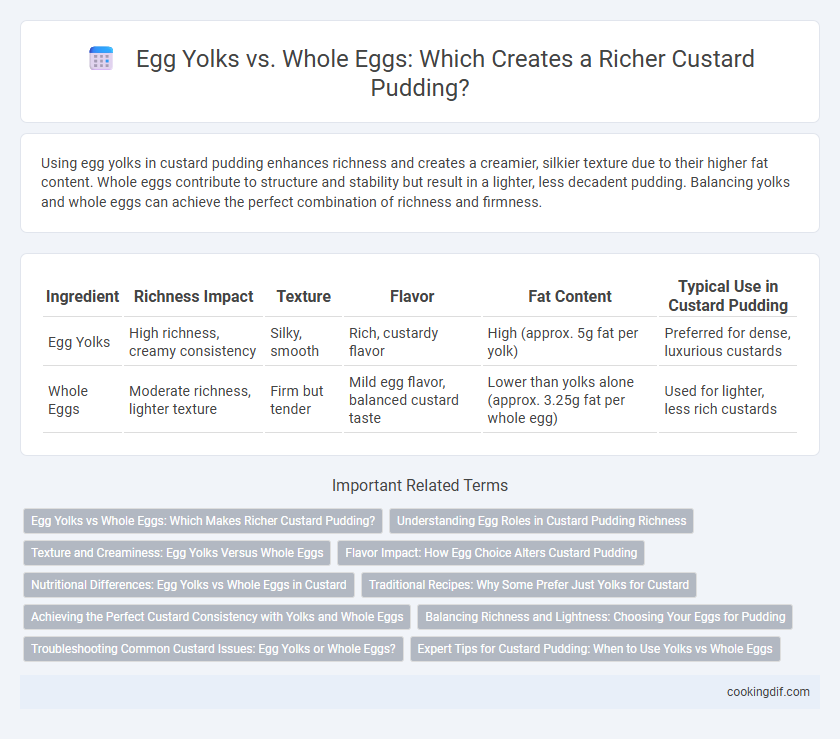Using egg yolks in custard pudding enhances richness and creates a creamier, silkier texture due to their higher fat content. Whole eggs contribute to structure and stability but result in a lighter, less decadent pudding. Balancing yolks and whole eggs can achieve the perfect combination of richness and firmness.
Table of Comparison
| Ingredient | Richness Impact | Texture | Flavor | Fat Content | Typical Use in Custard Pudding |
|---|---|---|---|---|---|
| Egg Yolks | High richness, creamy consistency | Silky, smooth | Rich, custardy flavor | High (approx. 5g fat per yolk) | Preferred for dense, luxurious custards |
| Whole Eggs | Moderate richness, lighter texture | Firm but tender | Mild egg flavor, balanced custard taste | Lower than yolks alone (approx. 3.25g fat per whole egg) | Used for lighter, less rich custards |
Egg Yolks vs Whole Eggs: Which Makes Richer Custard Pudding?
Egg yolks contribute more fat and emulsifiers, resulting in a creamier, richer custard pudding compared to whole eggs, which have a higher water content and produce a lighter texture. The higher fat content in yolks enhances mouthfeel and color, creating a smooth, velvety consistency ideal for luxurious custards. Using whole eggs balances richness with structure, but for maximum decadence and depth of flavor, egg yolks are preferred in custard pudding recipes.
Understanding Egg Roles in Custard Pudding Richness
Egg yolks contribute rich fats and emulsifiers that enhance custard pudding's creamy texture and deep flavor, making the dessert more luxurious. Whole eggs provide structure and binding due to their combined proteins, creating a firmer pudding but a less intense richness compared to yolks alone. Balancing yolks and whole eggs allows control over custard firmness and richness, optimizing the sensory experience of pudding.
Texture and Creaminess: Egg Yolks Versus Whole Eggs
Egg yolks contribute a richer, creamier texture to custard pudding due to their higher fat content and emulsifying properties, resulting in a smooth, velvety mouthfeel. Whole eggs, containing both yolks and whites, create a firmer custard with a slightly lighter texture, as the egg whites provide structure and help the pudding set more firmly. For optimal creaminess and luxurious texture, using primarily egg yolks or a higher yolk-to-white ratio enhances the custard's silkiness while maintaining stability.
Flavor Impact: How Egg Choice Alters Custard Pudding
Egg yolks enhance custard pudding's richness by contributing a creamy texture and intense flavor due to their high fat content and emulsifying properties. Using whole eggs results in a lighter, more balanced pudding with a milder taste and firmer structure. The choice between egg yolks and whole eggs significantly influences the custard's mouthfeel, sweetness perception, and overall flavor depth.
Nutritional Differences: Egg Yolks vs Whole Eggs in Custard
Egg yolks contain higher concentrations of fat, cholesterol, and essential nutrients like vitamins A, D, E, and B12, contributing significantly to the richness and creamy texture of custard pudding. Whole eggs provide a balanced mix of protein from the whites and fats from the yolks, resulting in a lighter, less dense custard texture. Nutritionally, using only yolks increases calorie content and fat levels, while whole eggs offer a more moderate nutritional profile with added protein and lower fat per serving.
Traditional Recipes: Why Some Prefer Just Yolks for Custard
Traditional custard pudding recipes often favor egg yolks over whole eggs to achieve a richer, creamier texture due to the higher fat content and emulsifying properties of yolks. Yolks contribute to a smooth, velvety mouthfeel and a deep golden color, enhancing the overall sensory experience. Using whole eggs can result in a lighter, more custard-like consistency but may sacrifice the intense richness characteristic of classic puddings.
Achieving the Perfect Custard Consistency with Yolks and Whole Eggs
Egg yolks contribute to a richer, creamier custard pudding due to their higher fat and emulsifier content, enhancing smooth texture and deep flavor. Whole eggs provide structure and stability, balancing richness while maintaining a lighter consistency. Using a combination of yolks and whole eggs allows precise control over custard thickness, creaminess, and mouthfeel for the perfect pudding consistency.
Balancing Richness and Lightness: Choosing Your Eggs for Pudding
Using egg yolks in custard pudding delivers intense richness and a creamy texture due to their high fat content and emulsifying properties. Whole eggs contribute both richness and structure, lending a lighter, more balanced consistency without overwhelming heaviness. Selecting the right ratio of egg yolks to whole eggs allows precise control over the pudding's richness and lightness, tailoring the final texture to preference.
Troubleshooting Common Custard Issues: Egg Yolks or Whole Eggs?
Using egg yolks in custard pudding enhances richness and creates a silky texture due to their higher fat content, but may result in a dense pudding that can curdle if overheated. Whole eggs contribute to a firmer, more set custard with a balanced flavor, yet they increase the risk of a rubbery texture and less creaminess. Troubleshooting common custard issues involves adjusting the egg ratio: increase yolks for creaminess without sacrificing structure, or use whole eggs cautiously to maintain stability while avoiding overcooking.
Expert Tips for Custard Pudding: When to Use Yolks vs Whole Eggs
Egg yolks contribute a richer, creamier texture to custard pudding due to their higher fat content and emulsifying properties, making them ideal for silky, luxurious desserts. Whole eggs provide structure and firmness, balancing richness with a slightly lighter texture, suitable for firmer custards or baked puddings. Expert tips suggest using primarily yolks for smooth, velvety custards and whole eggs when a more stable, sliceable custard base is desired.
egg yolks vs whole eggs for custard pudding richness Infographic

 cookingdif.com
cookingdif.com